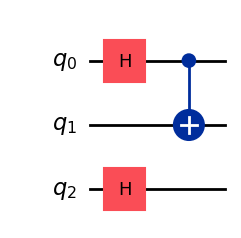Attention
This website is still under construction.
Enigma 001 : The Treasure Door#
The adventure starts here! Alice is walking on a distant planet. Suddenly, she comes across two guardians, two doors and a treasure. Will she be able to answer the riddle correctly to win the key to the treasure? A classic problem that can be translated on a quantum computer. It’s a nice way to make the leap into quantum programming and apply the concepts of state superposition, entanglement and quantum parallelism.
Make sure to watch the following video before getting started with these exercises:
Important
On this website, you will be able to write and run your own Python code. To do so, you will need to click on the “Activate” button to enable all the code editors and establish a connection to a Kernel. Once clicked, you will see that the Status widget will start to show the connection progress, as well as the connection information. You are ready to write and run your code once you see Status:Kernel Connected and kernel thebe.ipynb status changed to ready[idle] just below. Please note that that refreshing the page in any way will cause you to lose all the code that you wrote. If you run into any issues, please try to reconnect by clicking on the “Activate” button again or reloading the page.
Run the cell below to install the necessary packages.
import sys
!{sys.executable} -m pip install qiskit==1.1.1
!{sys.executable} -m pip install qiskit_aer==0.14.2
!{sys.executable} -m pip install pylatexenc==2.10
# Import necessary modules
import numpy as np
from qiskit import QuantumCircuit

Exercise 1 - Code writing#
Sometimes a quantum circuit can be simplified. One way of achieving this is by cancelling some quantum gates. Could you simplify the following circuit?
problem_qc = QuantumCircuit(3)
problem_qc.h(0)
problem_qc.h(2)
problem_qc.cx(0, 1)
problem_qc.barrier(0, 1, 2)
problem_qc.cx(2, 1)
problem_qc.x(2)
problem_qc.cx(2, 0)
problem_qc.x(2)
problem_qc.barrier(0, 1, 2)
problem_qc.swap(0, 1)
problem_qc.x(1)
problem_qc.cx(2, 1)
problem_qc.x(0)
problem_qc.x(2)
problem_qc.cx(2, 0)
problem_qc.x(2)
problem_qc.draw()

Try simplifying the circuit and rerun the calculation between each simplification to make sure you always get the same histogram. You can compare your answer to the solution.
problem_qc = QuantumCircuit(12)
### Start writing your code here. ###
# Visualize the circuit
problem_qc.draw('mpl')
Click to reveal the answer
problem_qc = QuantumCircuit(3)
problem_qc.h(0)
problem_qc.cx(0,1)
problem_qc.h(2)
# Visualize the circuit
problem_qc.draw('mpl')


Exercise 2 - Quick quiz#
Can you interpret the results of Question 1?

Exercise 3 - Quick quiz#
Launching algorithms on modern quantum computers does not always lead to 100% successful results, as some noise sometime causes bad results. If you launch the whole circuit on a real quantum computer, multiple times, what percentage of good answers might you get?

